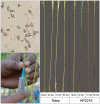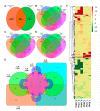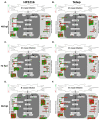Understanding Rice- Magnaporthe Oryzae Interaction in Resistant and Susceptible Cultivars of Rice under Panicle Blast Infection Using a Time-Course Transcriptome Analysis
- PMID: 33672641
- PMCID: PMC7924189
- DOI: 10.3390/genes12020301
Understanding Rice- Magnaporthe Oryzae Interaction in Resistant and Susceptible Cultivars of Rice under Panicle Blast Infection Using a Time-Course Transcriptome Analysis
Abstract
Rice blast is a global threat to food security with up to 50% yield losses. Panicle blast is a more severe form of rice blast and the response of rice plant to leaf and panicle blast is distinct in different genotypes. To understand the specific response of rice in panicle blast, transcriptome analysis of blast resistant cultivar Tetep, and susceptible cultivar HP2216 was carried out using RNA-Seq approach after 48, 72 and 96 h of infection with Magnaporthe oryzae along with mock inoculation. Transcriptome data analysis of infected panicle tissues revealed that 3553 genes differentially expressed in HP2216 and 2491 genes in Tetep, which must be the responsible factor behind the differential disease response. The defense responsive genes are involved mainly in defense pathways namely, hormonal regulation, synthesis of reactive oxygen species, secondary metabolites and cell wall modification. The common differentially expressed genes in both the cultivars were defense responsive transcription factors, NBS-LRR genes, kinases, pathogenesis related genes and peroxidases. In Tetep, cell wall strengthening pathway represented by PMR5, dirigent, tubulin, cell wall proteins, chitinases, and proteases was found to be specifically enriched. Additionally, many novel genes having DOMON, VWF, and PCaP1 domains which are specific to cell membrane were highly expressed only in Tetep post infection, suggesting their role in panicle blast resistance. Thus, our study shows that panicle blast resistance is a complex phenomenon contributed by early defense response through ROS production and detoxification, MAPK and LRR signaling, accumulation of antimicrobial compounds and secondary metabolites, and cell wall strengthening to prevent the entry and spread of the fungi. The present investigation provided valuable candidate genes that can unravel the mechanisms of panicle blast resistance and help in the rice blast breeding program.
Keywords: Magnaporthe; RNA-Seq; cell wall modification; disease resistance; panicle blast; rice.
Conflict of interest statement
The authors declare no conflict of interest.
Figures






Similar articles
-
Rice-Magnaporthe oryzae interactions in resistant and susceptible rice cultivars under panicle blast infection based on defense-related enzyme activities and metabolomics.PLoS One. 2024 Mar 7;19(3):e0299999. doi: 10.1371/journal.pone.0299999. eCollection 2024. PLoS One. 2024. PMID: 38451992 Free PMC article.
-
Comparative transcriptome profiling of the early response to Magnaporthe oryzae in durable resistant vs susceptible rice (Oryza sativa L.) genotypes.PLoS One. 2012;7(12):e51609. doi: 10.1371/journal.pone.0051609. Epub 2012 Dec 12. PLoS One. 2012. PMID: 23251593 Free PMC article.
-
The durably resistant rice cultivar Digu activates defence gene expression before the full maturation of Magnaporthe oryzae appressorium.Mol Plant Pathol. 2016 Apr;17(3):354-68. doi: 10.1111/mpp.12286. Epub 2015 Jul 14. Mol Plant Pathol. 2016. PMID: 26095454 Free PMC article.
-
Oscillating Transcriptome during Rice-Magnaporthe Interaction.Curr Issues Mol Biol. 2016;19:99-120. Epub 2015 Sep 11. Curr Issues Mol Biol. 2016. PMID: 26363736 Review.
-
Blast resistance in rice: a review of conventional breeding to molecular approaches.Mol Biol Rep. 2013 Mar;40(3):2369-88. doi: 10.1007/s11033-012-2318-0. Epub 2012 Nov 27. Mol Biol Rep. 2013. PMID: 23184051 Review.
Cited by
-
Identification and fine mapping of qPBR10-1, a novel locus controlling panicle blast resistance in Pigm-containing P/TGMS line.Mol Breed. 2021 Nov 30;41(12):75. doi: 10.1007/s11032-021-01268-3. eCollection 2021 Dec. Mol Breed. 2021. PMID: 37309514 Free PMC article.
-
Deciphering early responsive signature genes in rice blast disease: an integrated temporal transcriptomic study.J Appl Genet. 2024 Dec;65(4):665-681. doi: 10.1007/s13353-024-00901-z. Epub 2024 Aug 24. J Appl Genet. 2024. PMID: 39180632
-
Transcriptome Analysis of Protein Kinase MoCK2, which Affects Acetyl-CoA Metabolism and Import of CK2-Interacting Mitochondrial Proteins into Mitochondria in the Rice Blast Fungus Magnaporthe oryzae.Microbiol Spectr. 2022 Dec 21;10(6):e0304222. doi: 10.1128/spectrum.03042-22. Epub 2022 Oct 18. Microbiol Spectr. 2022. PMID: 36255296 Free PMC article.
-
A Novel Allele Encoding 7-Hydroxymethyl Chlorophyll a Reductase Confers Bacterial Blight Resistance in Rice.Int J Mol Sci. 2021 Jul 15;22(14):7585. doi: 10.3390/ijms22147585. Int J Mol Sci. 2021. PMID: 34299202 Free PMC article.
-
Rice-Magnaporthe transcriptomics reveals host defense activation induced by red seaweed-biostimulant in rice plants.Front Genet. 2023 Jun 23;14:1132561. doi: 10.3389/fgene.2023.1132561. eCollection 2023. Front Genet. 2023. PMID: 37424731 Free PMC article.
References
-
- Sharma T.R., Rai A.K., Gupta S.K., Vijayan J., Devanna B.N., Ray S.K. Rice Blast Management Through Host-Plant Resistance: Retrospect and Prospects. Agric. Res. 2012;1:37–52. doi: 10.1007/s40003-011-0003-5. - DOI
-
- Asibi A.E., Chai Q., Coulter J.A. Rice Blast: A Disease with Implications for Global Food Security. Agronomy. 2019;9:451. doi: 10.3390/agronomy9080451. - DOI
Publication types
MeSH terms
LinkOut - more resources
Full Text Sources
Other Literature Sources
Molecular Biology Databases
Research Materials
Miscellaneous

